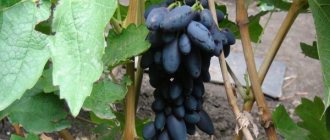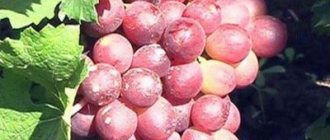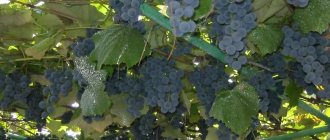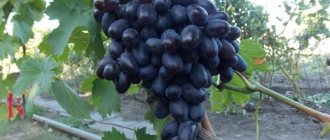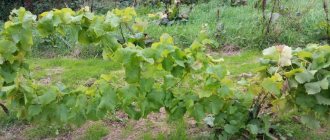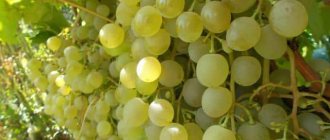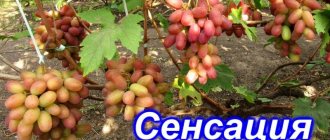In the conditions of the short and unpredictable summer of central Russia, it is extremely difficult to grow grape varieties with very large and sweet berries. Because they ripen well only in warm southern regions. But this does not mean at all that you will not be able to harvest grapes, for example, in the Moscow region. It's very possible. You just need to choose the right variety. And precisely the Zilga grape is the very variety that is most adapted to a changeable climate and short summer.
Caring for it will not require superhuman efforts from you. And you will harvest small but tasty berries every year. You don't even need a greenhouse for this. This grape variety grows well in open ground. Some gardeners do not even cover it for the winter. Because it has quite high frost resistance. We will talk about this and other characteristics of Zilga grapes later in the article.
What varieties are called technical
Zilga grapes: photo
The Zilga grape variety is technical. That is, this is a variety that is originally grown for making wine. But this does not mean at all that it cannot be consumed fresh. Or prepare, for example, juice. And this despite the fact that it is early ripening. And wine made from Zilga grapes is considered unusually tasty by many gourmets.
Technical varieties have common characteristics. Such grapes place less demands on the soil. And also unpretentious in care. By making minor mistakes, you will not ruin the harvest. Technical varieties are usually more frost-resistant than others. Even if the summer weather is not very pleasant, they still accumulate sugar. After full ripening, the berries do not spoil on the bush. On the contrary, they can accumulate more sugar.
Such varieties are easy to propagate and form. They are also amazing at their growth rate. Berries can be used not only for making wine, they are universal. Well, the last and very important characteristic. The yield of technical varieties is always at its best.
Pest control and disease prevention
Zilga grapes are resistant to various fungal diseases, but for prevention they should be treated with medicinal agents. Seedlings need grafting onto phylloxera-resistant rootstock. One preventive treatment of the plant against diseases - mildew, oidium and gray rot - will be required. The plant should be sprayed at the first signs of infection, and also as a preventive measure against diseases to which Zilga has no resistance.
Zilga is an unpretentious grape variety
Every summer resident will be able to grow a small but fruitful bush of Zilga grapes on his plot. This variety is perfect for all lovers of homemade wine and juice.
Zilga grapes: variety description and characteristics
These were the general characteristics of technical varieties. Now let’s look at the varietal characteristics of Zilga grapes in more detail. It was bred by the Latvian breeder Sukatnieks based on the Smuglyanka variety. Which was pollinated by the varieties “Yubileiny Novgorod” and “Dvietes Zilas”. The goal of the experiment was to obtain a variety that would produce a good harvest in the Latvian climate. And the experiment was definitely a success. And another variety is responsible for excellent frost resistance. It is this quality that is ensured by the Amur grape gene.
"Zilga" belongs to the early grape varieties. This means that the berries are ready for consumption within 3.5 months after flowering. The grapes are distinguished by high growth vigor. And also excellent ripening of shoots. The fruiting rate is over 80%. And this is a very high result.
To form a bush, experts recommend fan pruning. And also tie the plant to a trellis. The grapes are pruned, leaving about 7 “eyes” on the vine. "Zilga" can be combined with all kinds of rootstocks. There is no need to ration the harvest (remove some fruits so that the rest ripen properly). Because the plant has enough strength to ripen the entire crop.
If we talk about frost resistance, grapes can tolerate temperatures of -26 degrees without additional shelter. That is, only under snow cover. Without snow, even the most frost-resistant plant will freeze. Another undoubted advantage of the variety is its self-pollinating ability. As well as high resistance to major grape diseases (oidium and mildew). On a five-point scale – four points.
The berries are medium-sized and the bunch is very small (90-100 grams). Color blue. The sugar content in berries is 20-22%. They also do not have very high acidity. With good care, in a good year you can get 21-23 kilograms of grapes from a strong mature plant. Since wasps are indifferent to this grape variety, the berries, after full ripening, can hang on the branches for some time. Sometimes they even get raisinized.
Despite the fact that technical varieties are considered wine varieties, the Zilga variety is considered universal by many. And they use it both as a wine and table variety. And most gardeners note that it looks wonderful as a decoration for a terrace or gazebo.
Berries and bunches
The cross-reception of pollen by flowers leads to the formation of clusters of different shapes - from densely collected, homogeneous half-kilogram ones in the shape of a cylinder, to two-, three-lobed, or collected in a cone.
On average, no more than 3 clusters are formed on one sprout.
The clusters are formed under the leaves, but at the same time are in full view to receive the maximum amount of sunlight. Zilga translated into Russian means bluish, but the name of the variety does not sufficiently convey its color and taste characteristics. The resulting bunches are covered with berries:
- dark purple with a characteristic matte bluish coating;
- 2–3 rather large seeds;
- each weighing from 3 g;
- up to 50 pieces on each bunch;
- with a dense peel and jelly-like pulp.
The ripeness of the variety is indicated by a dark blue tint and a faint bloom of oval berries.
The purple juice obtained during processing contains up to 20% sugar, has a barely noticeable sourness, has a slight nutmeg aftertaste and scores 7 out of 10 on the taste scale. And this is a very good indicator for grapes grown in harsh northern conditions.
Reviews from gardeners
Reviews from gardeners speak of its ability to wilt on the bush, after reaching a state of technical ripeness, losing its juiciness and acquiring more and more sweetness. If weather conditions permit and the absence of wasps, grapes can be turned into raisins, filled with residual juice and very tasty.
Taste characteristics
The result of the work of the Latvian breeder P. Sukatnieks were berries with unique taste characteristics: low acidity (5 g/l), sweet (20% sugar), rich in vitamins and microelements , with pleasant pulp vaguely reminiscent of their predecessors, but original.
When and how to plant
Technical varieties, as we have already said, are not too demanding on soil fertility. Typically, soil requirements for grapes are limited to the following parameters. Low groundwater level, sandstone or loam. The soil acidity level is about 6. At the same time, experienced winegrowers note that the most delicious wine made from Zilga grapes is obtained when it grows on poor soil. Which contains mainly sand. And also a lot of stones.
When choosing a place for seedlings, remember that it should be well lit by the sun. And also have protection from the wind. If you plan to plant grapes next to a terrace or gazebo, then you need to place them on the south side.
As a rule, grapes are planted in spring or in the first half of autumn. Spring planting should be carried out after the threat of frost has passed and the ground has warmed up sufficiently (at least +10 degrees). If you plan to plant grapes in the autumn, be guided by the weather forecast; the plant should have time to take root before frost, and rooting will take at least a month. This rule determines the timing of autumn planting.
How to plant seedlings correctly
First of all, it is worth mentioning that it is best to buy grape seedlings from specialized grape nurseries that have extensive experience in growing the crop. Nowadays it is very easy to order vines in an online store.
- Plan to plant grapes in the spring or fall. For spring, pre-prepare the site and soil in the fall; for autumn, a month before the appointed time.
- Remember that grapes are a heat-loving plant; you should choose the most southern, sunny, windless and unshaded place on your site. If you have young trees in your garden, step back at least 3 meters from them.
- The hybrid is not picky about the composition of the soil, but grows best on light, slightly acidic soils with the addition of humus and peat. To prevent root rot, do not choose wet soil with a nearby groundwater source.
- Level the site, plan the rows.
- Zilga is a tall plant. It will require preliminary preparation of supports.
- Having received a seedling, take a good look at its root system, determine the quality of the roots by the cut, which should not be brown-rotten, but light green. Also evaluate the entire purchase as a whole.
- If the roots have dried out - which should not happen - put the vine in water for a day.
- Plant bushes at a distance of at least 3 meters from each other, retreat 1.5 meters in the row. Dig a hole 80x80x80 cm.
- After planting, water the plant thoroughly and water regularly throughout the week.
We invite you to read: How to preserve Moldova grapes for the winter
Choosing a landing site
The place for the Zilga grape variety must be prepared in advance, preferably a year before planting. If necessary, add a sufficient amount of sand to the soil. A hole for grapes must be dug quite large - about 65 cm deep and wide, and if you plan to plant more than one bush, then the distance between them should be at least one and a half meters. Although experienced winegrowers advise planting more densely, if you are going to grow grapes specifically for making wine, with such planting the quality of the wine is much higher.
Planting grape seedlings takes place in the following order: the hole is prepared in advance, immediately before planting, at least a bucket of warm water is poured into it. The soil with which you will then cover the roots must first be prepared; for this, mix the soil with rotted manure, adding phosphorus and potassium fertilizers (about 200 grams each). Then fill the hole a few centimeters with broken brick, crushed stone or expanded clay - this will provide the necessary drainage. Place a mound of earth on top of the drainage layer, place the seedling on it and very carefully spread its roots. Before you start filling the hole, secure a peg next to the seedling, which will initially serve as a support for it (this must be done now, so that later during installation you do not damage the roots of the grapes). Now you can fill the hole with the prepared nutrient mixture and water it with another bucket of warm water, after which you will mulch the soil around with humus or other material.
Zilga grapes and care for them
Caring for Zilga grapes is not much different from caring for other varieties and includes basic actions: timely watering and fertilizing, pruning and covering for the winter.
In the first years, it is recommended to water young plants four times.
- In the spring, after you have removed the shelter, you need to water the plant at the root using 35-40 liters of water, having first mixed it with ash. If the frost has completely passed, then water with warm water. If you need to delay the awakening of the grapes, then it is better to take cold water for watering.
- Water the grape bushes when they begin to bud.
- And then again, when the flowering is almost over.
- The final watering is called “moisture recharging” and is carried out about a week before the plant is to be covered for the winter.
And for adult bushes it is recommended to make do only with moisture-recharging watering.
Advantages and disadvantages
Photos of the Euro-American hybrid, which turns 55 years old this year, show relatively tall bushes with dense foliage, covered with beautiful clusters of bluish-purple berries. Breeders who have been cultivating Zilga for a long time are well aware of the advantages and disadvantages of the variety, and are convinced that its advantages outweigh its minor shortcomings:
The main advantage of the variety is its high yield and resistance to unfavorable climatic conditions.
- high yield ( up to 12 kg per bush );
- relatively high growth of both plants with their own root system and scions;
- short growing season ( 102–110 days );
- very early ripening (end of July under favorable weather conditions);
- large and juicy clusters ( from 200 to 400 g );
- bisexual flowers and virtually guaranteed 100% pollination ;
- annual shoots capable of ripening on 80–90%;
- possibility of growing in northern and temperate climates;
- 4-point resistance to oidium and the ability to limit yourself to 3 sprays;
- fruit buds with high resistance to frost ( up to -300C );
- excellent rooting and survival rate of new cuttings;
- possibility of growing without shelter;
- suitability for any type of use ( dining, industrial, wine );
- excellent shelf life and ability to withstand long-term transportation;
- undemanding to soil indicators and relatively unpretentious in care.
The hybrid bunches tolerate transportation well.
The spread of Zilga grapes is due not only to its undeniable advantages, but also to the high professional reputation of its creator P. Sukatnieks, who became the author of more than a hundred varieties. A significant role in the success of the breeder was played by the use of Smuglyanka as the mother variety, and a mixture of pollen from Dvietes zila and Yubileiny Novgorod as the parent pair.
A small fly in the ointment
Among the disadvantages, consumers cite the presence of dense skins on the berries and grains inside the pulp.
Gourmets consider the disadvantages of the variety to be the seeds inside the berries, sourness and thick peel.
Picky gardeners are unhappy with the need to constantly form a bush that arises from the constant and abundant growth of shoots. But in harsh climates, these are not disadvantages, but the growth characteristics of a plant created with the properties of high survival and resistance to external influences. They allow the bush to quickly recover and maintain the ability to continue the species.
Fertilizing and pruning the Zilga grape variety
The amount of fertilizer that you applied at the time of planting should be enough for the grapes for the first 2-3 years. Then the plant will begin to bear fruit and will need additional fertilizing throughout the season: in the spring, mainly nitrogen fertilizers, then during the flowering period, a complex mineral fertilizer should be used, during the ripening period the emphasis should be placed on potassium and phosphorus fertilizers, and after harvesting, it is necessary to apply only potassium. It is important to be very careful with nitrogen-containing fertilizers - after July, nitrogen should not be contained in complex fertilizers, as this inhibits the development of annual shoots.
In the spring, after removing the shelter, when the average daily temperature is above zero, it is necessary to inspect the plants and carry out “sanitary” pruning, removing all frozen or damaged shoots. Be careful, this must be done before the sap flow begins. In the summer months, stepsons should be removed, excess branches should be trimmed, and perhaps in the second half of summer you will have to tear off some of the leaves, which will shade the berries and interfere with their ripening.
The main pruning work should be carried out in the autumn. Remove all shoots that are not strong enough, and the rest should be trimmed according to the pattern, leaving about 6 “eyes”. It is believed that the Zigla grape variety does not need to be covered for the winter, but if the winter in your area is not snowy enough, then it is necessary to cover it, and in the first year this must be done especially carefully. There are many methods and materials for shelter, but the most reliable is considered to be a complex shelter with spandbond and spruce branches, and with the onset of winter, you definitely need to throw more snow on top of the shelter.
Care
With the onset of spring, shoots are pruned, leaving 5 - 7 eyes. The formation of the bush begins 2 years after planting. Weak stepsons are removed, leaving several healthy sleeves. It is important to carry out autumn pruning, removing excess branches that may interfere with wintering.
You need to water as needed several times in spring and summer, a month before the berries ripen, and also in the fall after the leaves fall. You need to spray with special solutions according to the instructions, depending on the diseases that have arisen. Periodically it is necessary to feed with organic and mineral fertilizers.
It is necessary to remove weeds in a timely manner, and remove cut branches and leaves away and burn them. This way you will protect the bush from possible fungi and pests.
Grapes "Zilga", description of the variety, photo, reviews of which you found on our website, can become a wonderful decoration for your site. From its tasty and juicy berries you can make healthy juices and wine.
[ads-pc-3] [ads-mob-3]
You can buy this variety here
Zilga grapes: reviews about the variety
Valentina, Vladimir
At one time, “Zilga” turned out to be my grape “debut”, bought out of curiosity on the principle “What if it works?” And you know, everything worked out great! I can’t say that I was an experienced gardener, but starting from the third year, my grape bush always pleased me with its harvest. Yes, these are not as sweet grapes as those brought from the southern regions, but I know how they grew, I know for sure that no chemicals were used on them, and I can say with confidence - don’t be afraid to try, this is not how to grow grapes difficult!
Alexander, Yegoryevsk
“Zilga” grapes can be recommended to anyone who is going to start growing grapes; this is exactly what is needed so as not to be disappointed in gardening. The plant does not get sick (there were aphids 2-3 times, but for a nine-year-old cultivation these are minor things), it tolerates winter well thanks to geotextiles, straw and snow, and the harvest allows you to make a sufficient amount of amazing homemade wine every year. So I highly recommend this variety to everyone.
Reviews
The Zilga hybrid has not yet been included in the State Register, but this does not prevent it from being one of the most popular varieties of our time. Beginning winegrowers begin to learn the basics from the Zilga grapes. This is no coincidence, because it takes root well on any land and in any climate. It does not require frequent fertilizing and sophisticated agrotechnical techniques.
Zilga is convenient because it grows and ripens in our region. The berries, although small, are quite sweet, and they also make good raisins. I cover it for the winter, although they talk about its frost resistance, but I’m afraid. The plant is resistant to diseases, but wasps cause trouble.
I have been cultivating this variety for ten years - mainly for raisins, juice and jam. There are no problems with grapes when it comes to care, they just grow quickly - a lot of pruning is necessary. I haven’t noticed any particular tendency to diseases, although for prevention I treat it with a fungicide twice a season. The berries have a hard skin, but birds love them - they add to the worries, I usually cover the plants with a protective net.
Advantages: high yield, unpretentiousness, resistance to various diseases, good frost resistance;
Disadvantages: hard berry skin, not the best taste, requires careful pruning, susceptible to wasps and birds.
Zilga grapes: results
Let's be honest, these are not the largest berries and may not have the greatest taste.
But nevertheless they are tasty, ripening every year in large quantities. And the main advantage of the “Zilga” variety can be considered that it is able to grow and fully bear fruit almost anywhere in our vast country with its very different climate. So if you are planning to plant your first grape bush, I recommend that you start with the Zilga variety. Zilga grapes: video
conclusions
The valuable qualities of the varietal hybrid and the resulting abundant harvest can be used for decorative, culinary and industrial purposes.
Zilga grapes are perfect for dessert on the summer and autumn table, for making juice and jam, wine and soft drinks. Even an inexperienced gardener can grow it; in a small area, it can be used simultaneously for decorative purposes on arches and walls, and at the same time receive a wonderful harvest of berries of unique taste.


